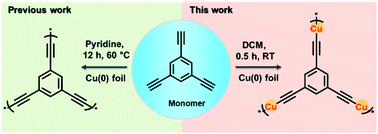Solvent-mediated engineering of copper-metalated acetylenic polymer scaffolds with enhanced photoelectrochemical performance†
Abstract
The covalent linking of acetylenes presents an important route for the fabrication of novel carbon-based scaffolds with potential utilities in a large variety of applications. Beyond that, the incorporation of metal atoms into the acetylenic scaffold could significantly improve its physical, chemical and electronic properties, but the synthesis of such metalated materials remains a challenge. Herein, we demonstrate a solvent-mediated strategy for tailoring conjugated acetylenic polymers from metal-free to copper-metallated diacetylenic linkages. The metalation extends light absorption and promotes charge transport in acetylenic polymers. As a result, the Cu-metallated acetylenic polymers on a photocathode exhibit a hydrogen-evolution photocurrent density of 7–70 μA cm−2 at 0.3 V vs. the reversible hydrogen electrode, which is superior to that of their metal-free counterpart. This work offers a feasible strategy to modulate the Cu-metalation of acetylenic polymers, which may inspire further studies in this field.



 Please wait while we load your content...
Please wait while we load your content...